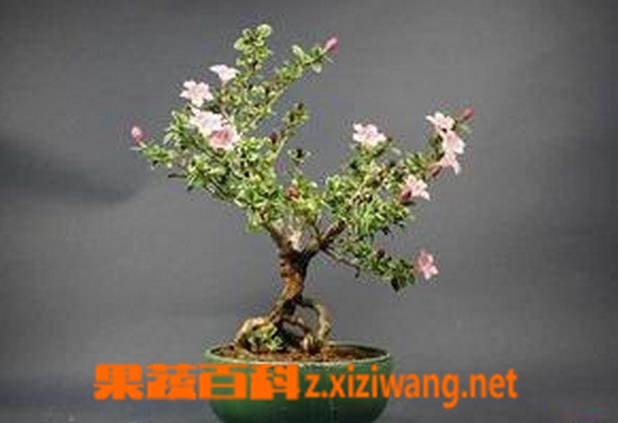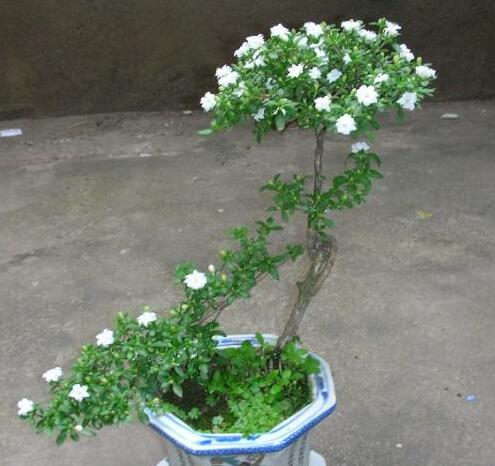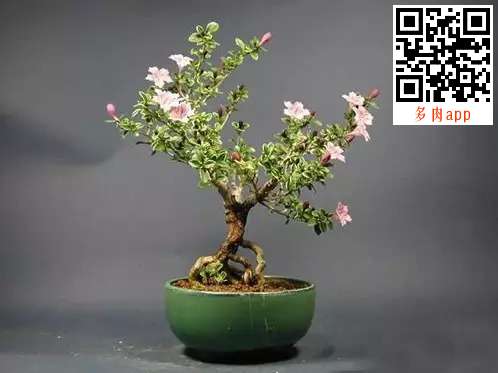The production of snow bonsai in June
Brief introduction of snow bonsai in June
June snow, also known as the sky star, is an evergreen or semi-evergreen dwarf shrub. It has many branches and dense branches, the plant is low and short, and the exposed one is only about 1 meter high. Like overcast, wet and warm climate, not resistant to severe cold, lax requirements for soil. With small leaves, flexible branches and well-developed roots, it is very suitable to make bonsai.
June snow can propagate separately in spring and March, branch or root cuttings can be carried out from February to November, and 2-3-year-old seedlings can begin to process and shape. The snow branches in June are soft and flexible, and it takes a long time from modeling to shaping, which takes about 2 to 3 years to finalize.
Production of snow bonsai in June
June snow, which is used to make bonsai, can also be excavated in the wild, ramet in March, or cutting in the rainy season. Because June snow has unique modeling quality, growers can carry out artistic processing according to the branch shape characteristics of the plant, not only into general straight dry type, oblique dry type, horizontal dry type, jungle type, but also according to some characteristics of June snow itself. made into cliff type, root-lifting type, stone-attached type or multi-dry type with roots, and so on.

The production method of snow bonsai in June
The method of making snow bonsai in June-soil
Snow in June is popular. It is the earliest flower to bloom after winter, bringing spring flavor to everyone. June snow itself likes the light very much, and it is also suitable for dry land and cold land. June snow has a strong vitality, so the requirement for the soil is not high. In the June snow bonsai, you can choose a mixture of rotten leaf soil and general soil, which is good for planting June snow and contributes to its growth.
Second, the production method of snow bonsai in June-- pruning
The June snow bonsai needs to be pruned, which can effectively help the whole branch to be trimmed evenly, making the shape of the June snow potted plant more uniform and beautiful. Pruning is also conducive to the emergence of new lateral buds, thus helping to increase the flowering of the whole bonsai. If the branches will be pruned when the snow sprouts in June, it will be more conducive to flowering. It is not suitable for pruning June snow in autumn and winter, so a certain amount of time will make June snow open in spring.
The production and maintenance of snow bonsai in June the snow in June is also known as white horse bones, stars, and daily spring flowers. it is an evergreen or semi-deciduous dwarf shrub of Rubiaceae, named for its small white flowers such as snow in summer. With graceful trees, sparse branches and leaves, exquisite and elegant, it is not only a beautiful flower and foliage tree species in landscaping, but also an excellent bonsai material. it is one of the five famous trees in Lingnan bonsai, known as "Rocks of Eighteen Scholars". It is one of the bonsai plants exported to the United States after China's entry into WTO. First, the growth habit of June snow like warm and humid environment, like light, shade, drought, pruning, slightly cold, like fertilizer, soil requirements are not strict, neutral and slightly acidic soil can adapt. Second, the source and processing shape of pile wood June snow is often propagated in spring and March, and branch or root propagation can be carried out at any time from 2mi to October. If protected ground (seedbed) is used for propagation, cuttings can be carried out from November to January of the following year. After planting, pay attention to shading, heat preservation, moisturizing, the survival rate is very high. 2Mel-3-year-old seedlings can be processed and modeled, often after semi-deciduous leaves in winter to before sprouting in spring, the trunk and main branches are tied with wire, and the branchlets are shaped by fine pruning. The branches of June snow are soft and easy to bend, but it takes a long time to finalize. It takes about 2-3 years to remove the flat binding material (that is, wire). It is best to re-tie the shape several times to prevent the sinking of silk from affecting the growth of the plant and the beauty of the tree. In the provinces and regions of southeastern and central China, wild old piles or young trees can also be excavated in the mountains and processed into pots after being planted in the ground. Technical points of potting in June Xue should be transplanted in 2murs-March. it can also be carried out during the Meiyu season and late autumn. Choose a lighter round, square or oval purple sand pottery basin or glazed pottery basin, the color of the basin should be slightly darker, in contrast to the flower color. The basin soil is required to be a sandy loam rich in organic matter, loose and fertile, with good drainage and permeability, and can be mixed with pastoral soil, humus soil and pine needle soil mixed with 40% sand or rice husk ash. Properly trim the root when putting on the basin, and the pile material that needs to be processed into exposed root bonsai or with elegant stone into stone-attached bonsai can be carried out when putting on the basin. After potting, make a fine pruning of the upper branches and leaves (that is, cut off the branches and leaves that have nothing to do with the shape and affect the beautiful shape), and pay attention to proper shading and frequent water spray to maintain moisture to ensure its survival and normal growth. 4. Technical points of maintenance and management 1. Water and fertilizer management: snow bonsai in June should be often watered during the growing season to keep the basin soil moist, spray foliar water twice a day in summer, pay attention to inspection in the rainy season, avoid stagnant water in the basin; in winter, watering times should be appropriately reduced. Generally, 3Muk should be watered once in 6 days (when the basin soil surface is slightly dry and slightly white). Before flowering (that is, 4muri-May), 3 times a year, 0.5% phosphate and potassium fertilizer solution with a concentration of 0.3% Murray will be applied; during the season of Ladong, a dilute organic fertilizer solution will be applied twice, so it is not suitable to apply fertilizer in other seasons. Avoid applying thick fertilizer. 2. Light and temperature requirements: June snow is a subtropical tree species, avoid strong sunlight exposure, summer should shade 50%-70%. In winter, you can spend the winter outdoors in the south; in the north, you should move indoors and keep room temperature at 5 ℃ 12 min. 3. Turning the basin and pruning: usually turn the basin and change the soil once every 1-2 years, in spring, 2-March or late autumn, replace all the old soil, trim the roots properly, and lift the roots combined with changing pots to form suspended roots and improve the ornamental value. After the semi-deciduous leaves in winter to the sprouting of the following spring, one pruning is carried out to cut the long and overgrown branches, to remove the overdense thin and weak branches, to cut off the branches of diseases and insect pests and other messy branches that affect the ornamental, and to pick the core, wipe the buds and remove the branches at the right time during the growing period, so as to keep it in a beautiful shape. The cut healthy branches can be used for cutting propagation. 4. Pest control: there are few diseases and insect pests in snow bonsai in June, and aphids and snails occur occasionally. once they occur, they should be prevented and treated in time. Aphids can be diluted 600 times with wind oil essence, or sprayed 150 times with neutral detergent; snails can be poisoned on the basin surface with an appropriate amount of 80% Miaoling granules, or 1500 times with 58% wind and lightning EC. When the basin soil is too wet or stagnant water in the basin for too long, root rot will occur, and attention should be paid to prevention and control. Turn the basin and change the soil in time when the basin soil is solidified, and be careful not to make the basin soil too wet for a long time, and avoid stagnant water in the basin. At the beginning of the disease, you can use 12% green EC 600ml-1000 times, or 50% Gen Fu Ling 800x solution to irrigate roots and leaves, spray (irrigation) once every 5 days, continuous spray (irrigation) for 4 times. For plants with serious disease, they should be taken out of the basin, replaced with new culture soil, washed clean and cut off the diseased roots, and soaked in the roots for 30 minutes, and then replanted in the pot, the plants can generally be saved. Experience exchange: June cold knife: a basin of June snow bonsai cut by Lingnan bonsai technique, article | Spring bonsai garden map of June snow (also known as full sky star), Rubiaceae June snow genus, evergreen or semi-evergreen shrubs. Sexual light is also shady, warm and humid, slightly cold-resistant, widely distributed throughout the country, extremely resistant to pruning, is an excellent material for the production of small bonsai, while large piles are rare. The production method of bonsai is mainly to tie branches and cut pieces (pieces of clouds), paying attention to the tree-shaped ornamental effect. Because of its slim material and small size, most people think that June snow is not suitable to use Lingnan bonsai techniques to produce Lingnan bonsai style works with prominent branches and claws. Figure 2, figure 1 and figure 2 are the trees before pruning, while the pot below is a pot of snow and stone bonsai made by me using the Lingnan bonsai technique. Today, I trim, take photos and attach text instructions for everyone to exchange, and welcome to make comments. Fig. 3 under the growing condition, the branches and leaves of June snow are relatively dense, and some twigs without light and ventilation are easy to shrink and die. If we prune the snow bonsai in June for a long time, it will certainly increase the number of useful young branches and affect the shape and type preservation in the future. The author believes that the best way to solve this problem is to use the Lingnan bonsai production technique of "cutting cold branches" and changing brocade, and while implementing this method, it is also easy to adjust the tree shape and branch shape, so as to make the branches and claws of trees show strength beauty. this is also the basic requirement of Lingnan bonsai. In order to deepen everyone's impression, I have given this method of "cutting cold branches" a good-sounding name called "June cold knife", of course, for June snow. All right, let's start this work: figure 4, pruning the tree phase June snow height 65cm figure 5 has been pruned. In the heat of summer, although the bright green branches and leaves of June snow are covered with white flowers like snow, it brings a trace of coolness to the heart, but now it is a different taste to take off your clothes and look at the cold branches. Some people chat on Wechat, while others learn and grow up on Wechat every day. A lot of our time now is fragmented, you can use it to be in a daze, you can also use it to play games, you can also follow some high-quality Wechat official accounts, growing a little bit every day. Boutique WeChat: [new Seedling Merchants] "New Seedling Merchants" integrates perfect seedling training, seedling exhibitions, green seedlings, flower and tree information services, e-commerce services and resource integration services. Since its establishment, it has been committed to providing information and business services for customers in the greening industry. National unified service hotline: 15000226 0538 Mustang / Guangdong / 941 if you need to release supply and demand information, please contact ↓↓ [email]: 100372****@qq.com [customer service hotline]: 0538 / 538 / 941 subscription and contribution 1. Go back to the top of the article and click "New Seedling Merchants" to subscribe (recommended) 2. Search number: qlylwta0538 or Sogong account "Xinmiao Merchants" 3. Contribution email: 137*10@qq.com follows the "New Miao Merchants" Wechat official account to read more information.
- Prev

Breeding method of June snow
The propagation of snow in June is mainly by cutting, and it can also be divided and striped. The main results are as follows: 1. Cutting propagation is mostly carried out in the rainy season. Choose branches that are strong and disease-free, cut them into cuttings 8 to 10 centimeters long, and insert them directly into plain sand. Pour water after insertion and shade properly
- Next

Production and maintenance of snow bonsai in June
1. June snow bonsai production June snow leaves small, small flowers, stem curve, well-developed roots, tangled roots, many branches, strong germination, can be made into single-dry type or Shuanyu type, multi-dry type, stone-attached type, cliff type and other bonsai. (1) material selection. From March to April in spring
Related
- Fuxing push coffee new agricultural production and marketing class: lack of small-scale processing plants
- Jujube rice field leisure farm deep ploughing Yilan for five years to create a space for organic food and play
- Nongyu Farm-A trial of organic papaya for brave women with advanced technology
- Four points for attention in the prevention and control of diseases and insect pests of edible fungi
- How to add nutrient solution to Edible Fungi
- Is there any good way to control edible fungus mites?
- Open Inoculation Technology of Edible Fungi
- Is there any clever way to use fertilizer for edible fungus in winter?
- What agents are used to kill the pathogens of edible fungi in the mushroom shed?
- Rapid drying of Edible Fungi

